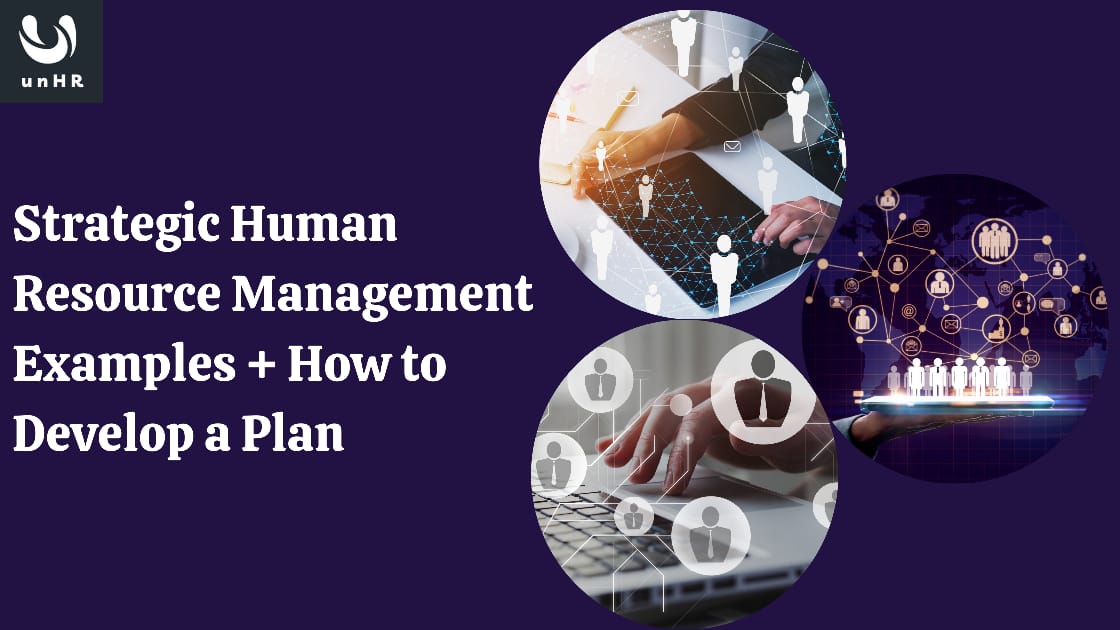Strategic Human Resource Management Examples + How to Develop a Plan

In today’s competitive market, human resource management for startups is pivotal in aligning business goals with workforce capabilities. Effective HR management and benefits ensure that a company attracts and retains the right talent while streamlining processes. This blog explores strategic HR management examples, practical steps to develop a plan, and how leveraging technology and human resource management enhances organizational success.
Understanding Strategic Human Resource Management (SHRM)
Strategic HR management (SHRM) is an approach that links human resource policies and practices with the organization’s overarching objectives. Businesses can create a workforce that aligns with their goals by focusing on long-term HR planning. Startups, in particular, benefit significantly from adopting a strategic approach, ensuring that their limited resources are optimized.
Critical Components of a Strategic HR Management Plan
- Goal Alignment: Align HR goals with the company’s mission and vision. For example, a tech startup may focus on talent acquisition management to hire developers with niche skills.
- Workforce Planning: Analyzing current workforce capabilities and future needs helps in human resources recruitment and selection, ensuring that the right talent is acquired to meet projected goals.
- Performance Management: Define performance metrics and establish regular reviews to maintain high productivity. This aspect of HR management and benefits includes setting clear expectations and rewarding achievements.
- Training and Development: Invest in upskilling employees to foster innovation and adaptability. Continuous learning is critical in an evolving market, especially in technology-driven industries.
- Use of HR Technology: Implementing HRMS tech automates core HR functions, from tracking attendance to employee engagement. A robust HRMS system enhances data accuracy and reduces administrative tasks, allowing HR professionals to focus on strategic activities.
Examples of Strategic HR Management in Action
- Talent Acquisition for Growth: A company aiming for rapid growth may focus on talent acquisition management by adopting a comprehensive recruitment process. They might collaborate with agencies specializing in human resources recruitment and selection or use HR software that leverages AI to shortlist candidates.
- Employee Retention Through Benefits: Some organizations create personalized HR management and benefits packages to retain talent. For instance, tech startups often provide flexible work schedules and remote options to attract and retain top talent.
- Technology-Driven HR Transformation: Implementing technology and human resource management tools such as AI-driven recruitment platforms can streamline hiring. Additionally, HRMS tech implementation helps businesses manage employee data efficiently, supporting informed decision-making.
- Succession Planning: It is crucial to prepare future leaders within the organization. Startups can develop internal talent pools through mentorship programs, ensuring leadership and organizational culture continuity.
- Performance-Based Culture: Startups focusing on performance create a culture where employees are rewarded based on achievements. This includes regular feedback and reviews and supporting organizational growth and individual development.
Steps to Develop an Effective Strategic HR Management Plan
- Conduct a SWOT Analysis: Identify strengths, weaknesses, opportunities, and threats related to HR capabilities. This evaluation can uncover potential areas for growth and enhancement, such as upgrading technology and human resource management systems.
- Set HR Objectives Aligned with Business Goals: Define measurable HR objectives that directly support the company’s goals. These could involve enhancing human resources recruitment and selection or implementing efficient HR management and benefits packages.
- Develop Action Plans: Create detailed steps for each objective, such as adopting HRMS tech implementation for streamlining HR processes or setting up a talent pipeline for rapid hiring.
- Invest in HR Technology: Tools such as HRMS tech implementation streamline various HR tasks and reduce manual work. Empower HR professionals to prioritize strategic goals over everyday administrative tasks.
- Review and Adjust: Regularly assess the plan’s effectiveness and make necessary adjustments. Feedback from employees and managers can provide insights into areas that need refinement.
FAQs on Strategic Human Resource Management
Q. What is strategic human resource management (SHRM)?
- SHRM aligns HR policies and practices with an organization’s long-term goals to improve performance and efficiency.
Q. How can human resource management for startups benefit from SHRM?
- Startups benefit from SHRM by ensuring their limited resources are optimized to attract and retain top talent, supporting rapid growth.
Q. What role do HR management and benefits play in SHRM?
- It includes implementing employee benefits and creating a nurturing workplace atmosphere, vital for drawing in and retaining skilled employees.
Q. How do technology and human resource management influence HR strategies?
- HR departments can automate processes, make data-driven decisions, and enhance productivity by implementing tools like HRMS.
Q. What is an example of HRMS tech implementation?
- Examples include using an HRMS platform to manage employee attendance, payroll, performance evaluations, and streamlining HR functions.
Q. What are some strategic HR management examples?
- Examples include talent acquisition planning, performance-based culture, employee retention through personalized benefits, and succession planning.
Q. How can startups implement human resources recruitment and selection efficiently?
- Startups can adopt AI-driven recruitment tools, streamline interview processes, and collaborate with specialized agencies to source the right talent.
Q. Why is talent acquisition management critical in SHRM?
- It ensures organizations can identify, attract, and retain the best talent, supporting business goals and growth.
Q. What is the importance of performance management in SHRM?
- Performance management helps maintain high productivity and clear expectations and fosters a goal-oriented work environment.
Q. How does an HR technology system, like HRMS tech implementation, improve HR operations?
- HRMS reduces manual tasks, enhances data accuracy, and enables HR to focus on strategic planning by automating core HR processes.







